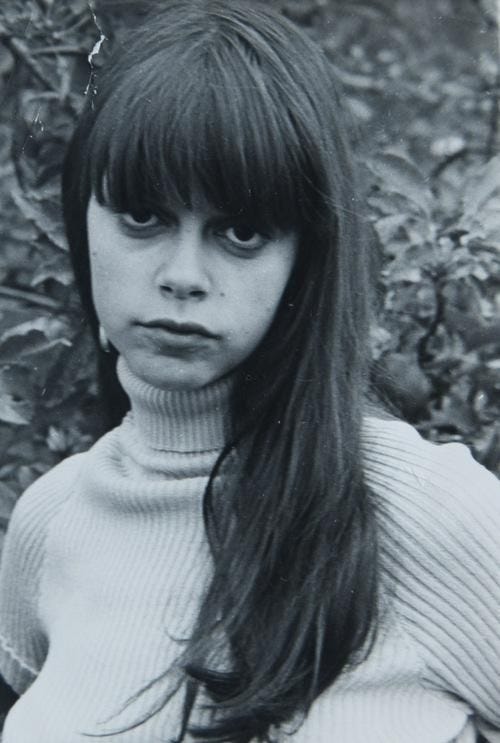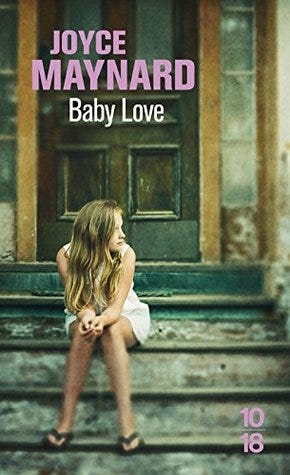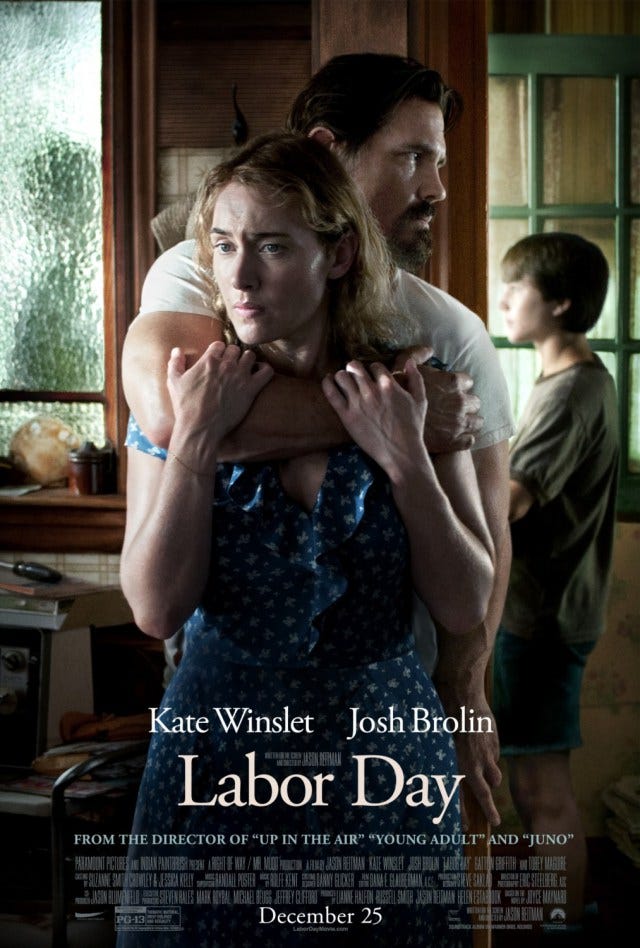AMERICA’S MOST OVER-LOOKED CRIME NOVELIST
When crime-fiction aficionados gather to discuss the current state of the art, one name is almost never listed among today’s best crime writers: Joyce Maynard. But I believe it ought to be. Thanks to their Hollywood iterations, To Die For (published in 1992) and Labor Day (2009) are Maynard’s best-known novels. Both are flat-out American crime novels, as true to the genre as anything ever written by Patricia Highsmith or Jim Thompson. But they are not the only crime fiction Maynard has written. Her very first novel, Baby Love (1981), is steeped in criminality. The plot includes blackmail, kidnapping, a sex slave, torture, rape, the burning of an abortion clinic, the escape of a dangerous madman from an asylum, and murder. Curiously, the publisher chose to market it as chick lit. My Avon paperback copy carries this blurb from the New York Daily News on the cover: “Funny, sexy, and full of devastating insights.” The back cover promises the reader “a picture-postcard New Hampshire town” in which “young mothers and would-be mothers are trying to live out America’s TV and Top 40 fantasies.” It goes on to identify four of those young women – Sandy, Tara, Wanda, and Carla – and then tells us how motherhood or the prospect thereof has shaped their lives. Fine. All of that is in the novel. But the book description makes no mention of Loretta, a former toll-booth operator who is held prisoner by a psychopath for three years and used for sex. When she becomes pregnant, her tormentor murders her after first botching an attempted abortion. No mention is made of Ann, either, though she is the psychopath’s next intended victim. Baby Love is a tapestry that deftly weaves together the lives of a dozen or so citizens of small-town New Hampshire. I suppose it is a women’s novel as well as a literary novel, but it is also a crime novel, albeit one without a central mystery.
If Baby Love is a crime novel without a mystery, The Good Daughters (2010) is a mystery novel without a crime. The central mystery concerns the parentage of its two main characters, and it is as compelling and complex as any gothic novel by Daphne DuMaurier. (fun fact: Maynard’s first name is Daphne; Joyce is her middle name).
After Her (2013) is set in Marin County and is loosely based on the murders committed by a notorious California criminal known as The Trailside Killer. It is dark and disturbing and it evokes Northern California as well as any contemporary crime novel I know of.
Under The Influence (2016) is a dark novel about a woman whose life changes forever after she commits a relatively minor crime (DUI). She finds herself caught in the orbit of a wealthy couple whose crimes are even worse (think Chappaquiddick; think Bernie Madoff). It may be the closest Maynard has come to channeling the ghost of Patricia Highsmith. Like Highsmith, Maynard is more interested in the emotional violence humans can wreak upon each other than in the physical violence they wreak. Both Under The Influence and Where Love Goes (1995) are filled with people wreaking emotional violence upon those they are closest to.
Even Maynard’s nonfiction reflects her interest in crime. The true-crime book Internal Combustion (2006) is exactly what its subtitle says it is: The Story of a Marriage and a Murder in the Motor City. One of her best-known personal essays (“The One Good Man”) is about her frightening correspondence with an imprisoned killer.
So why is Joyce Maynard not considered a crime writer? I have a few answers, some benign and some not so benign.
ONE: Maynard writes well in a lot of different genres: journalism, memoir, young-adult fiction, mainstream literary fiction, crime fiction, and so forth. It’s hard to pigeonhole a writer who never pigeonholes herself.
TWO: She is a female. The crime-fiction genre has become more female-friendly over the last couple of decades as writers like Gillian Flynn and Tana French have been embraced both by fans of crime fiction and fans of serious non-genre fiction. There have always been excellent women writing crime fiction: Agatha Christie, P.D. James, Ruth Rendell, Sue Grafton, Marcia Muller, Highsmith etc. But most of these women made it easy for themselves to be recognized as crime writers by creating a crime-fighting character and then reusing him or her in book after book. It’s tougher to establish a reputation as a crime writer if you don’t return again and again to the same name-brand sleuth, such as Hercule Poirot or Kinsey Milhone. Likewise, many of today’s best-known crime writers specialize in a particular geographical locale. Carl Hiaasen writes about south Florida, Connelly writes about L.A., Tana French writes about Ireland. Maynard, on the other hand, has written books set in northern California, Detroit, New Hampshire, and elsewhere. She is a shape-shifter, and you can’t pigeon-hole a shape-shifter, which makes it more difficult to market her work.
THREE: Maynard tends to experiment with point of view in a way that is not commonplace in crime fiction. Generally crime novelists create a character like Harry Bosch or Lew Archer and then give us the entire story though that person’s eyes. That’s not how Maynard works. Baby Love has a dozen or more viewpoint characters. The narrative consists of numerous short sections, each one told from the point of view of one of those dozen or so main characters. All of these are rendered in third person. To Die For also jumps around among different characters, but all of its sections are narrated in the first person by characters possessing unique and quirky voices. Maynard seems to re-invent herself with each new book. In that regard she has more in common with Margaret Millar than with Kenneth Millar (Margaret’s husband, who used the pseudonym Ross Macdonald). I prefer Margaret’s books to Kenneth’s, but the conventional wisdom says that he was the better of the two. If you’re fond of the conventional, you may not like Maynard’s work.
FOUR: For all their darkness and disturbing events, most of Maynard’s work is also characterized by domesticity. Labor Day is as much about pies as it is about crime. It’s hard to imagine saying something like that about a Michael Connolly novel. Baby Love really does have a lot of babies in it (born, unborn, in the planning stage, etc.), but it also has a rapist, a murderer, and a reclusive writer who uses up impressionable young acolytes in much the same way as J.D. Salinger used the young Joyce Maynard.
Which brings us to FIVE: The Salinger Factor. J.D. Salinger is an idol to millions of American readers and thousands of American writers. And people generally don’t take kindly to those who expose the foibles of their heroes. Maynard did just that in her brilliant and painful memoir At Home in the World (1998). For telling the truth about the emotional abuse and mistreatment she suffered during the eleven months or so that she co-habited with Salinger, when he was in his fifties and she was a teenager, Maynard became the target of a great deal of wrath and critical abuse. The backlash was so strong that, even though she has continued to grow and improve as a writer, every new book she writes tends to get treated, by at least some critics, as an opportunity to once more scold Maynard for what she divulged in At Home in the World (see Caitlin Flanagan’s take down of Maynard’s 2017 memoir The Best of Us in The Atlantic, in which six paragraphs are spent revisiting At Home in the World and finding its author guilty of “over-sharing”). This type of treatment seems to be an occupational hazard for female memoirists. Every new Kathryn Harrison book provides an opportunity for certain critics to once again scold her for publishing The Kiss, a memoir of her incestuous relationship with her father. To critics like that, Maynard will never be cleansed of her sins.
On May 5, 2018, I – along with seven other aspiring memoirists and personal essayists – spent a day with Joyce Maynard, in the writing room of her Marin County home. The critique she gave me of my own material was helpful, but the assistance she gave to the only other male writer in the seminar was downright spellbinding. At the beginning of the day, the gentleman in question (let’s call him Mr. X) pulled up a pant leg and showed us the electronic monitor on his ankle. He informed us that he was serving time for a federal crime. He’d recently been released from prison but was not allowed to leave home except to go to work. He’d been granted a special dispensation by his parole officer to attend the seminar. During the financial collapse of 2008 he and some other real-estate investors had conspired to rig the bidding on houses auctioned at foreclosure sales. Mr. X (whose father was also a crooked real-estate investor) hoped to write a memoir about his experiences that would act as a cautionary tale for his son, thus ending the family’s cycle of criminality. As Maynard listened to the barebones outline of his story her eyes lit up and her imagination went to work. She grilled Mr. X as though he were the witness to a murder. She sketched out the details of his story on a whiteboard at the front of the room. After thirty minutes or so the whiteboard looked like something from an episode of Law and Order, with all the main plot points ringed in big circles, and arrows corkscrewing in every direction, to connect one point to another in a progression that would allow the story to build in the most dramatic fashion possible (“You might want to start with your own arrest,” she’d say, “and then go all the way back and tell about how you used to attend foreclosure sales with your own father back in the 1960s.”). Watching it happen, I felt as though I were present at the birth of a great American crime novel. I suspect that when Mario Puzo first began sketching out the idea that became The Godfather he was possessed of the same kind of manic energy as Maynard displayed up at that whiteboard. By the time she was done all of us in that room were eager to see Mr. X’s story in print.
Alas, the story isn’t Maynard’s to tell. Mr. X’s book may never come to your neighborhood bookstore. But there are probably quite a few Joyce Maynard titles at that store. It would be a crime to miss out on them.







